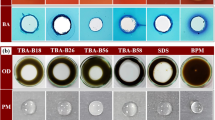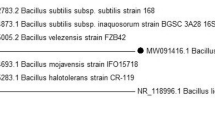Abstract
PhytopathogenicCorynebacterium species and related soil microbes were examined for their ability to produce surfactants from hydrocarbon substrate. Surfactant production was detected by the lowering of both surface and interfacial tensions, by the formation of high reciprocal critical micelle concentrations (CMCs), and by the possession of properties of emulsification and demulsification. Whole broth cultures of severalC. fascians strains,C. insidiosum ICPB CI13A,Arthrobacter paraffineus NRRL B-3453, andNocardia amarae NRRL B-8176 lowered surface tensions from 58.5 mN/m to 27–33 mN/m, lowered interfacial tensions from 33.5 mN/m to 0.55–4.0 mN/m, and had high reciprocal CMCs. Whole-broth cultures ofN. amarae NRRL B-8176 had excellent demulsification ability; those of someC. fascians strains andC. insidiosum ICPB CI13A produced unusual gel-like emulsions. These properties are believed to aid in the attachment of phytopathogenic corynebacteria to the surfaces of host plants.
Similar content being viewed by others
Literature Cited
Agrios, G. N. 1969. Plant pathology. New York, London: Academic Press.
Arim, K., Kakinima, A., Tamura, G. 1968. Surfacting, a crystalline peptide lipid surfactant produced byBacillus subtilis: Isolation, characterization and its inhibition of fibrin clot formation. Biochemica et Biophysica Research Communications31:488–494.
Bauer, W. D. 1977. Plant cell walls, pp. 6–23. In: Smith, H. (ed.), Botanical monographs, vol. 14. The molecular biology of plant cells. Berkeley, Los Angeles: University of California Press.
Beebe, J. L., Umbreit, W. W. 1971. Extracellular lipid ofThiobacillus thiooxidans. Journal of Bacteriology108:612–614.
Buchanan, R. E., Gibbons, N. E. (eds.). 1974. Bergey's manual of determinative bacteriology. Baltimore: Williams and Wilkins.
Cooper, D. G., Zajic, J. E. 1980. Surface-active compounds from microorganisms. Advances in Applied Microbiology26:229–253.
Cooper, D. G., Zajic, J. E., Gerson, D. F. 1979. Production of surface-active lipids byCorynebacterium lepus. Applied and Environmental Microbiology3:4–10.
Gerson, D. F., Zajic, J. E. 1977. Bitumen extraction from tar sands with microbial surfactants, pp. 705–710. In: Redford, D. A. Winestrock, A. G. (eds.), The oil sands of Canada-Venezuela 1977, CIM special volume 17. The Canadian Institute of Mining and Metallurgy.
Gerson, D. F., Zajic, J. E. 1978). Surfactant production from hydrocarbons byCorynebacterium lepus, sp. nov. andPseudomonas asphaltenius, sp. nov. Developments in Industrial Microbiology19:577–599.
Gutierrez, J. R., Erickson, L. E. 1977. Hydrocarbon uptake in hydrocarbon fermentations. Biotechnology and Bioengineering19:1331–1349.
Hall, J. L., Flowers, T. J., Roberts, R. M. 1974. Plant cell structure and metabolism. London: Longman.
Hisatsuke, K., Nakahara, T., Sono, N., Tamada, K. 1971. Formation of Rhamnolipid byPseudomonas aeruginosa: Its function in hydrocarbon fermentations. Agricultural and Biological Chemistry35:686–692.
Kates, M. 1972. Techniques of lipidology. New York: Elsevier North-Holland.
Knettig, E., Zajic, J. E. 1972. Flocculant production from kerosene. Biotechnology and Bioengineering14:379–390.
Makula, R. A., Lockwood, P. J., Finnerty, W. R. 1975. Comparative analysis of the lipids ofAcinetobacter species grown on hexadecane. Journal of Bacteriology121:250–258.
Margaritis, A., Kennedy, K., Zajic, J. E., Gerson, D. F. 1979. Biosurfactant production byNocardia erythropolis. Developments in Industrial Microbiology20:623–630.
Raymond, R. L., Jamison, V. W. 1971. Biochemical activities ofNocardia. Advances in Applied Microbiology14:93–122.
Suzuki, T., Tanaka, K., Matsubara, I., Kinoshita, S. 1969. Trehalose lipid anda-branched-b-hydroxy fatty acid formed by bacteria grown onn-alkanes. Agricultural and Biological Chemistry33:1619–1627.
Tanford, C. 1973. The hydrophobic effect: Formation of micelles and biological membranes. New York: John Wiley and Sons.
Zajic, J. E., Guignard, H., Gerson, D. F. 1977. Emulsifying and surface active agents fromCorynebacterium hydrocarboclastus. Biotechnology and Bioengineering19:1285–1301.
Zajic, J. E., Guignard, H., Gerson, D. F. 1977. Properties and biodegradation of a bioemulsifier fromCorynebacterium hydrocarboclastus. Biotechnology and Bioengineering19:1303–1320.
ZoBell, C. E. 1946. Action of micro-organisms on hydrocarbons. Bacteriological Reviews10:1–49.
Author information
Authors and Affiliations
Rights and permissions
About this article
Cite this article
Akit, J., Cooper, D.G., Manninen, K.I. et al. Investigation of potential biosurfactant production among phytopathogenic corynebacteria and related soil microbes. Current Microbiology 6, 145–150 (1981). https://doi.org/10.1007/BF01642388
Issue Date:
DOI: https://doi.org/10.1007/BF01642388




